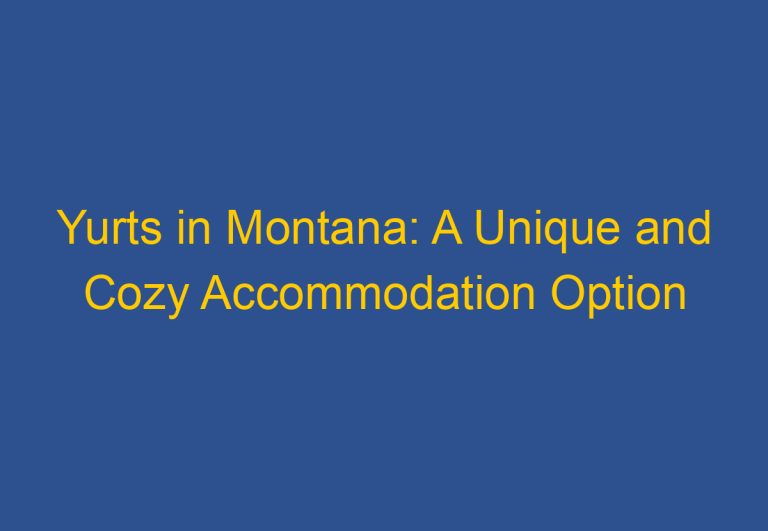Do You Need a Permit to Put Up a Yurt? A Guide to Yurt Permitting Requirements
Yurts have become increasingly popular over the years as a unique and affordable housing option. These circular tents are easy to set up and can be used for a variety of purposes, from a simple backyard retreat to a full-time residence. However, before you set up a yurt, it’s important to know whether or not you need a permit.
The answer to whether or not you need a permit to put up a yurt depends on a variety of factors. Building code requirements can vary greatly and yurts do not always fit neatly into just one category within the code books. Variables such as the size and use of the yurt as well as the site can help determine if the yurt will require a permit and what type of permit may be needed.
Yurts can be considered temporary or permanent structures depending on their intended use and how they are constructed. As a result, the rules and regulations surrounding yurt permits can be complex and vary from state to state and even from county to county. In this article, we will explore the factors that determine whether or not you need a permit to put up a yurt and provide some guidance on navigating the permitting process.
Understanding Yurt Permits and Building Codes
Permit Requirements for Yurts
Before setting up a yurt, it is important to understand whether a building permit is required in your area. In most cases, a building permit is required for permanent yurts, while temporary yurts may not require one. However, the exact requirements vary depending on the jurisdiction and the intended use of the yurt.
When applying for a permit, it is important to provide detailed plans of the yurt, including its size, intended use, and location. The building department will review the plans and ensure that they meet the local building codes and safety regulations.
Building Codes and Safety Regulations
Yurts are considered alternative structures and are subject to the same building codes and safety regulations as other structures. The International Building Code (IBC) and the International Residential Code (IRC) are the most commonly used codes for building yurts. These codes cover a wide range of areas, including fire safety, electricity, plumbing, and occupancy.
In addition to the IBC and IRC, there may be local zoning laws and regulations that must be followed. These regulations may cover areas such as fire-rating requirements, energy codes, and zoning regulations.
Jurisdictional Variations in Yurt Regulations
It is important to note that yurt regulations vary widely depending on the jurisdiction. Some areas may have specific regulations that apply only to yurts, while others may have no regulations at all. It is important to research the local laws and regulations before setting up a yurt.
Building officials can provide information on the specific requirements for yurts in their jurisdiction. They can also help with the building permit process and ensure that all code regulations are met.
In summary, understanding the permit requirements and building codes for yurts is crucial before setting one up. It is important to research the local regulations and work with building officials to ensure that all code requirements are met.
Practical Considerations for Yurt Installation
Installing a yurt requires careful planning and consideration to ensure a successful and enjoyable experience. This section will cover some practical considerations that should be taken into account when installing a yurt.
Selecting the Right Location and Foundation
One of the first things to consider when installing a yurt is the location and foundation. Yurts can be installed on a variety of surfaces, including platforms, decks, and even directly on the ground. However, it is important to ensure that the surface is level, stable, and able to support the weight of the yurt.
In addition to the foundation, the location of the yurt should also be carefully considered. Factors such as wind speed, snow load, and seismic rating should be taken into account when selecting a location. It is also important to consider any local regulations or covenants that may apply.
Design and Customization of Yurts
Yurts come in a variety of sizes and designs, and can be customized to fit a variety of purposes. Whether you are looking for a permanent residence, a semi-permanent structure, or a temporary camping yurt, there is a yurt that can meet your needs.
When selecting a yurt, it is important to consider factors such as insulation, heating, and electrical requirements. It is also important to consider any engineering specs or standards that may apply, as well as any local regulations or building codes.
Maintenance and Longevity of Yurts
Finally, it is important to consider the maintenance and longevity of your yurt. Yurts are generally low-maintenance structures, but it is important to ensure that they are properly maintained to ensure their longevity.
Factors such as wood stove maintenance, cleaning, and repairs should be taken into account when planning for the maintenance of your yurt. It is also important to consider any local regulations or building codes that may apply, as well as any manufacturer recommendations.
Overall, installing a yurt can be a rewarding and enjoyable experience. By taking the time to carefully consider the location, design, and maintenance of your yurt, you can ensure that your yurt will provide you with many years of enjoyment and comfort.
Frequently Asked Questions
What are the legal requirements for erecting a yurt on private property?
The legal requirements for erecting a yurt on private property vary depending on the state and county in which the property is located. In general, yurts are considered temporary structures and may require a permit for installation. It is recommended to check with the local zoning and building departments for specific regulations and requirements.
Are there specific counties in California that are yurt-friendly?
Yes, there are several counties in California that are yurt-friendly, including Mendocino, Humboldt, and Santa Cruz. However, it is important to note that regulations and requirements may vary by county, and it is recommended to check with the local zoning and building departments before installing a yurt.
What building codes apply to the construction of a yurt?
Building codes for yurts may vary by state and county. In general, yurts must meet certain structural requirements, such as snow load, wind resistance, and fire safety. It is recommended to consult with the local building department for specific building codes and requirements.
Is it possible to reside in a yurt on a full-time basis?
Yes, it is possible to reside in a yurt on a full-time basis. However, it is important to note that some states and counties may have regulations and requirements for yurt living, such as minimum square footage, plumbing, and heating. It is recommended to check with the local zoning and building departments for specific regulations and requirements.
How does the cost of building a yurt compare to traditional housing?
The cost of building a yurt can vary depending on the size, materials, and location. In general, yurts can be a more affordable option compared to traditional housing. However, it is important to consider additional costs, such as permits, site preparation, and utilities.
What regulations govern yurt living in Oregon?
In Oregon, yurt living is regulated by the Oregon State Building Codes Division. Yurts must meet certain structural requirements, such as snow load, wind resistance, and fire safety. It is recommended to consult with the local building department for specific building codes and requirements.












